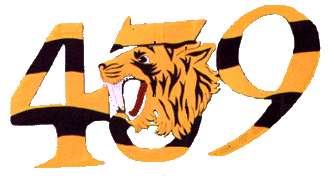| Reveille was early - very early - on the morning of D-Day. For
the maintenance crews indeed there was little, if any sleep as they worked
the night through to ensure that every aircraft was “on
top line" ready for operations. At
0645 in the morning of 6 June the first formation of Typhoons (No. 440
Squadron) took off, followed by No. 438 at 0655 and No. 439 five minutes
later. Every man in W/C Hillock’s wing felt that he had a part,
and a very important part, in the initial assault.
The
Typhoons had been assigned the task of neutralizing enemy coastal batteries just before the landing craft touched down on the beaches. The targets for S/L Norsworthy's twelve pilots were two gun
positions behind the beach-head at Courseulles where the Third Canadian
Division was to land, When the twenty-four 1,000 lb. bombs exploded both
batteries were believed to be "a
long distance removed." Bellowing clouds of "smoke
and corruption" hung over the beaches as the heavy guns of the navy added their
intense fire to the bombardment.  This aerial shot shows elements of the Canadian Third Division breaking out from the beaches, Troops, some still in the water, wade ashore while unloaded equipment crowd the beaches. Photo source Old House Books
Tanks
were seen landing on some beaches and, so far as the pilots could judge,
appeared to be meeting no resistance in the early stage of the assault.
"Aircraft
of all descriptions" - except enemy - filled every corner of the sky. It was an
unforgettable scene of concentrated sea, land and air power.
Once the landings had been made the Wing's role was to provide
close support for the ground forces as they fought their way inland
towards Caen. At 1640 No.
439 went out again to attack "targets
of opportunity" but none could be found although the pilots searched the Caen
area from heights as low as 500 feet. Only two of our own armoured
scout cars were seen, pushing south from Courseulles. The third
sortie, three hours later, had better luck.
F/L Tommy Dadson was leading his group of eight (which included
the Wing C.O. Frankie Hillock) on a search for enemy armored
vehicles near Caen when he suddenly, and unexpectedly, came upon a
large column heading northwards.
|
 Tiger
Squadron
Tiger
Squadron  Tiger
Squadron
Tiger
Squadron